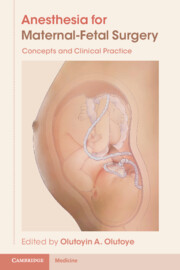Book contents
- Anesthesia for Maternal-Fetal Surgery
- Anesthesia for Maternal-Fetal Surgery
- Copyright page
- Dedication
- Contents
- Contributors
- Abbreviations
- Preface
- Acknowledgments
- Section 1
- Section 2
- Section 3
- Chapter 10 Myelomeningocele Repair
- Chapter 11 Lung Masses
- Chapter 12 Sacrococcygeal Teratoma
- Chapter 13 Ex-Utero Intrapartum Therapy
- Index
- Endmatter
- References
Chapter 13 - Ex-Utero Intrapartum Therapy
from Section 3
Published online by Cambridge University Press: 19 November 2021
- Anesthesia for Maternal-Fetal Surgery
- Anesthesia for Maternal-Fetal Surgery
- Copyright page
- Dedication
- Contents
- Contributors
- Abbreviations
- Preface
- Acknowledgments
- Section 1
- Section 2
- Section 3
- Chapter 10 Myelomeningocele Repair
- Chapter 11 Lung Masses
- Chapter 12 Sacrococcygeal Teratoma
- Chapter 13 Ex-Utero Intrapartum Therapy
- Index
- Endmatter
- References
Summary
Advanced imaging of the mid-gestation fetus has allowed for the early detection and monitoring of conditions that may impact the delivery of the baby. Large head and neck masses that will likely compromise ventilation at birth can therefore be easily diagnosed with plans for securing the airway at birth. Ex-utero intrapartum therapy has greatly enhanced survival for such affected infants at birth. The success of this approach in providing advanced airway management at delivery has also been extended to the treatment of other conditions that may be life-threatening within the first few minutes to hours of life.
Keywords
- Type
- Chapter
- Information
- Anesthesia for Maternal-Fetal SurgeryConcepts and Clinical Practice, pp. 191 - 206Publisher: Cambridge University PressPrint publication year: 2021



